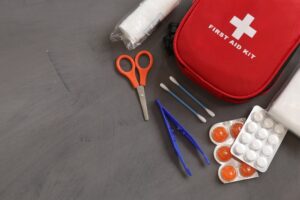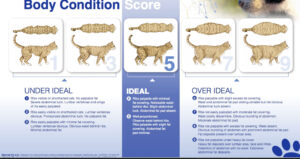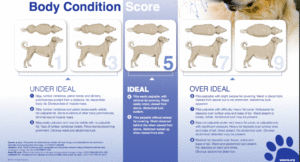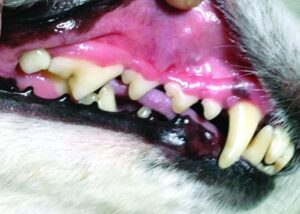Common household products, plants, and some natural products, can be poisonous for pets when consumed accidentally or given to the wrong pet, wrong medication or wrong dose. The following list is not comprehensive. To read more about the subject go to
https://www.aaha.org/your-pet/pet-owner-education/ask-aaha/Household-Toxins/.
Human foods and household items
 Pets are not “mini people.” Animals react to substances in food and medicines differently from people. Most pets are much smaller than people, so what may seem like a harmless amount of a food or drug can make them ill
Pets are not “mini people.” Animals react to substances in food and medicines differently from people. Most pets are much smaller than people, so what may seem like a harmless amount of a food or drug can make them ill
Several common ingredients in human food can be toxic to pets. These are some of them:
- Avocados
- Grapes and raisins (kidney damage in dogs, cats, and ferrets)
- Baker’s chocolate and cocoa powder are the most dangerous because they can cause vomiting, diarrhea, excessive thirst and urination, hyperactivity. increased heart rate, abnormal heart rhythms, tremors, and seizures
- Macadamia nuts
- Onions, garlic, and chives
- Xylitol, a common sugar-free sweetener can lower the blood sugar in the body and cause life-threatening liver failure
- Yeast dough
- Coffee, caffeinated drinks and alcohol
- Insecticides, cleaning products, fire logs, paints. Read the warning labels on these products and store as directed.
Plants, lawn and garden products
Plants: Many common plants found in flower beds, vegetable gardens, and indoor planters and arrangements can be toxic to pets. Tomatoes, lilies, azalea, cyclamen, daffodils, dieffenbachia, and hyacinth are examples of common ornamentals that can be toxic.
Pest poisons/rodenticides
Poisons meant to kill rodents, insects, or weeds are very common causes of poisoning in pets. Store any poisons around your home in a secured placed away from children and pets.
Garden products
Cocoa mulch, fertilizers, and compost piles are also unsafe for pets. Keep your pet out of areas treated with toxic products. Compost piles can grow bacteria and fungi that are highly toxic to pets, so if you have a compost pile, make sure your pet cannot get into it
Over-the counter medications/Human prescription medications

Many common over-the-counter drugs can be extremely toxic to pets. Never give your pet a medicine meant for people unless you’ve been told to by a veterinary professional.
Natural products are marketed toward humans as well as pets. However, natural products may be dangerous in overdose situations. Although many natural products are very safe others can be deadly after ingestion. The most dangerous ingestions include 5-HTP, alpha lipoic acid, hops and cholecalciferol. These products can cause life-threatening signs if timely treatment is not sought.
Essential oils are very popular in human and veterinary products. In general, they are very safe but if applied to wounds and abraded skin or in the ear can cause problems. Toxicity is dose-dependent.
Garage chemicals
Any chemical in your garage can be dangerous to pets. Antifreeze is very dangerous because of its sweet taste and severe irreversible renal damage can be deadly. Store all chemicals out of the reach of your pet and carefully clean any spills.
In an Emergency…
If your pet does eat something he or she shouldn’t, time is critical. Call your veterinarian or an animal poison hotline immediately.
The ASPCA Animal Poison Control Center’s hotline number is 888-426-4435.
The Pet Poison Helpline number is 855-764-7661.

Dr. APGC







 The general recommendation is that dogs need at least 30 minutes of physical activity a day, and cats should strive for three 5-minute intense play periods. If you are unable to maintain this routine, consider hiring a pet walking service or taking your furry baby to a pet day care so he/she can interact with other pets
The general recommendation is that dogs need at least 30 minutes of physical activity a day, and cats should strive for three 5-minute intense play periods. If you are unable to maintain this routine, consider hiring a pet walking service or taking your furry baby to a pet day care so he/she can interact with other pets
 Obesity is not just the accumulation of large amounts of adipose tissue, but is associated with important metabolic and hormonal changes in the body. Few diseases in modern veterinary medicine are diet-induced, with one possible exception, obesity. The cause of obesity is multifactorial, with genetics, physical activity, and diet energy content as predisposing factors. There are numerous concerns regarding obesity; the first one is that it seems to be increasing in prevalence. Furthermore, excess body fat has adverse metabolic consequences, including insulin resistance, altered hormonal secretion, changes in metabolic rate, abnormal lipid metabolism, and fat accumulation in visceral organs.
Obesity is not just the accumulation of large amounts of adipose tissue, but is associated with important metabolic and hormonal changes in the body. Few diseases in modern veterinary medicine are diet-induced, with one possible exception, obesity. The cause of obesity is multifactorial, with genetics, physical activity, and diet energy content as predisposing factors. There are numerous concerns regarding obesity; the first one is that it seems to be increasing in prevalence. Furthermore, excess body fat has adverse metabolic consequences, including insulin resistance, altered hormonal secretion, changes in metabolic rate, abnormal lipid metabolism, and fat accumulation in visceral organs. Numerous studies demonstrated that obesity could have detrimental effects on the health and longevity of dogs and cats. Like obese pet parents, obese companion animals may be predisposed to other serious conditions, including orthopedic disease, diabetes mellitus, abnormalities in blood lipid values, cardiorespiratory disease, urinary disorders, reproductive disorders, and renal cancers. A lifelong study in dogs showed that even moderately overweight dogs were at greater risk for earlier mortality. Likewise, obese cats face increased health risks, including arthritis, diabetes mellitus, fatty liver disease, and early mortality. The risk for the development of diabetes increases in overweight cats and is about fourfold in obese cats.
Numerous studies demonstrated that obesity could have detrimental effects on the health and longevity of dogs and cats. Like obese pet parents, obese companion animals may be predisposed to other serious conditions, including orthopedic disease, diabetes mellitus, abnormalities in blood lipid values, cardiorespiratory disease, urinary disorders, reproductive disorders, and renal cancers. A lifelong study in dogs showed that even moderately overweight dogs were at greater risk for earlier mortality. Likewise, obese cats face increased health risks, including arthritis, diabetes mellitus, fatty liver disease, and early mortality. The risk for the development of diabetes increases in overweight cats and is about fourfold in obese cats.
 Controlling our pets’ weight is one of the two (we discussed the other in this
Controlling our pets’ weight is one of the two (we discussed the other in this  confinement in a poorly ventilated area, strenuous exercise, and/or being left in a vehicle even on a relatively cool day as temperatures inside vehicles can increase rapidly regardless of the outside temperature. Heatstroke can affect all dog breed of any age but, long-haired and brachycephalic breeds (Pugs, Bulldogs and other flat-faced breeds) are more susceptible. Other predisposing characteristics include age (young puppies or geriatric dogs), obesity, pre-existing diseases and physical condition.
confinement in a poorly ventilated area, strenuous exercise, and/or being left in a vehicle even on a relatively cool day as temperatures inside vehicles can increase rapidly regardless of the outside temperature. Heatstroke can affect all dog breed of any age but, long-haired and brachycephalic breeds (Pugs, Bulldogs and other flat-faced breeds) are more susceptible. Other predisposing characteristics include age (young puppies or geriatric dogs), obesity, pre-existing diseases and physical condition. Unlike humans, dogs do not sweat but eliminate heat by panting instead. Dogs have some sweat glands in the footpads, which help with heat dissipation, but only minimally. When panting is not enough, a dog’s body temperature rises. This can be fatal if not corrected quickly. Signs of heat stroke are excessive panting, signs of discomfort, unable or unwilling to move around, red mucous membranes, hypersalivation, rapid heart rate, dry nose, vomiting, diarrhea muscle tremors, seizures, ataxia (impaired coordination), coma and death.
Unlike humans, dogs do not sweat but eliminate heat by panting instead. Dogs have some sweat glands in the footpads, which help with heat dissipation, but only minimally. When panting is not enough, a dog’s body temperature rises. This can be fatal if not corrected quickly. Signs of heat stroke are excessive panting, signs of discomfort, unable or unwilling to move around, red mucous membranes, hypersalivation, rapid heart rate, dry nose, vomiting, diarrhea muscle tremors, seizures, ataxia (impaired coordination), coma and death. If you suspect heatstroke, stop all activity and walk or carry your dog to a cool, shaded area with good air circulation. It is essential to remove the dog from the hot environment immediately. Let your dog drink as much cool water as he wants without forcing him to drink. If you have access to a rectal thermometer, you should take your dog’s temperature. A dog’s normal body temperature is 98.5 to 102.5 F, and heatstroke is classically defined as a core body temperature above 105.8 F. If the temperature is higher than 105 F, using cool, not cold, water; sponge or hose your dog’s entire body, especially the underside, use of a fan is also helpful. After a few minutes retake the temperature and repeat this procedure until the temperature is reduced to 103 F. If the dog is unconscious, place a towel on his back and continue to soak the towel and your dog in cold water. Do NOT submerge your dog’s head in the water. Keep the head elevated to prevent aspiration pneumonia. If the symptoms do not improve quickly and you are unable to take your dog’s temperature take your dog to your veterinarian immediately. On the way to the veterinarian, travel with the windows open and the air conditioner on. It is important to remember that heatstroke in dogs can cause undetected problems, such as swelling of the brain, kidney failure, intestinal bleeding and abnormal blood clotting.
If you suspect heatstroke, stop all activity and walk or carry your dog to a cool, shaded area with good air circulation. It is essential to remove the dog from the hot environment immediately. Let your dog drink as much cool water as he wants without forcing him to drink. If you have access to a rectal thermometer, you should take your dog’s temperature. A dog’s normal body temperature is 98.5 to 102.5 F, and heatstroke is classically defined as a core body temperature above 105.8 F. If the temperature is higher than 105 F, using cool, not cold, water; sponge or hose your dog’s entire body, especially the underside, use of a fan is also helpful. After a few minutes retake the temperature and repeat this procedure until the temperature is reduced to 103 F. If the dog is unconscious, place a towel on his back and continue to soak the towel and your dog in cold water. Do NOT submerge your dog’s head in the water. Keep the head elevated to prevent aspiration pneumonia. If the symptoms do not improve quickly and you are unable to take your dog’s temperature take your dog to your veterinarian immediately. On the way to the veterinarian, travel with the windows open and the air conditioner on. It is important to remember that heatstroke in dogs can cause undetected problems, such as swelling of the brain, kidney failure, intestinal bleeding and abnormal blood clotting. If they are alert enough and able to drink water, offer small amounts frequently. You can add some tuna water or chicken broth to the water to encourage them to drink. Avoid the following: forcing your cat to drink water or pouring water into their mouth, cooling its body with ice or extremely cold water, submerging him in water. Do NOT cool off your cat too fast or skip the trip to the vet. Temperatures can spike again, and there may be damage to internal organs. Unfortunately, cats can be exceptionally good at hiding health problems. If you notice your cat exhibiting any of the symptoms described in dogs and/or sweaty feet, disorientation, restlessness, lethargy and rectal temperature above 105º F bring your cat immediately for veterinary evaluation and care.
If they are alert enough and able to drink water, offer small amounts frequently. You can add some tuna water or chicken broth to the water to encourage them to drink. Avoid the following: forcing your cat to drink water or pouring water into their mouth, cooling its body with ice or extremely cold water, submerging him in water. Do NOT cool off your cat too fast or skip the trip to the vet. Temperatures can spike again, and there may be damage to internal organs. Unfortunately, cats can be exceptionally good at hiding health problems. If you notice your cat exhibiting any of the symptoms described in dogs and/or sweaty feet, disorientation, restlessness, lethargy and rectal temperature above 105º F bring your cat immediately for veterinary evaluation and care.
 Healthy skin starts with good nutrition. A dog’s/cat’s skin and coat require vitamins, minerals, essential fatty acids, and other nutrients. A low-quality diet can leave their coat looking dry, cause dandruff and make the pet prone to skin infections. As with other health conditions, prevention is the best policy. Regularly brushing your furry babies prevents skin infections because it helps remove allergens and helps condition their skin. Start by petting your baby, next carefully inspect the skin taking notice of any lumps, bumps, cuts, scabs, or scaly skin. Regular bathing is also as important to maintain a healthy coat. If you are like most of us and tend to delay your furry baby’s bath because it is a struggle, make a habit of taking your doggy/kitty to a professional groomer. However, if you are a DIY-kind of person make sure that you use best quality dog/cat shampoos, conditioners and brushes specifically made for your pet’s breed and coat type.
Healthy skin starts with good nutrition. A dog’s/cat’s skin and coat require vitamins, minerals, essential fatty acids, and other nutrients. A low-quality diet can leave their coat looking dry, cause dandruff and make the pet prone to skin infections. As with other health conditions, prevention is the best policy. Regularly brushing your furry babies prevents skin infections because it helps remove allergens and helps condition their skin. Start by petting your baby, next carefully inspect the skin taking notice of any lumps, bumps, cuts, scabs, or scaly skin. Regular bathing is also as important to maintain a healthy coat. If you are like most of us and tend to delay your furry baby’s bath because it is a struggle, make a habit of taking your doggy/kitty to a professional groomer. However, if you are a DIY-kind of person make sure that you use best quality dog/cat shampoos, conditioners and brushes specifically made for your pet’s breed and coat type.



 Well, you finally made the decision…whether this is your first puppy, or you had this experience before, this is an exciting time!! For the next few days, you will experience a wide range of feelings from “This’s the best decision of my life” to “OMG what have I done!” In other words you might feel that you entered the Twilight Zone…but just like bringing home your new born baby for the first time, this will be the beginning of many years of fun and love and licks that will fill your home with great memories of happiness and companionship!!
Well, you finally made the decision…whether this is your first puppy, or you had this experience before, this is an exciting time!! For the next few days, you will experience a wide range of feelings from “This’s the best decision of my life” to “OMG what have I done!” In other words you might feel that you entered the Twilight Zone…but just like bringing home your new born baby for the first time, this will be the beginning of many years of fun and love and licks that will fill your home with great memories of happiness and companionship!!

 the breeder, your pup is between 7 and 12 weeks. This is a critical learning period that will last until he is about 16 weeks old, so make the most of this rapid learning stage. The goal is for him to have lots of positive experiences with friendly people, children, other dogs, and cats. During this time, your puppy should meet many different people, not just the same family members or friends. To get the numbers up, take your puppy for walks to different places, take him to short car rides and to do errands where you can introduce him to different people. Meeting new people and having lots of different experiences are important to help him cope and adapt to different situations. During these outings, take him to see his veterinarian for a short visit so he gets used to these visits. There are a few things your puppy should learn at this point: Meeting people is great; No teeth on people ever; No jumping up on people; Always potty outside.
the breeder, your pup is between 7 and 12 weeks. This is a critical learning period that will last until he is about 16 weeks old, so make the most of this rapid learning stage. The goal is for him to have lots of positive experiences with friendly people, children, other dogs, and cats. During this time, your puppy should meet many different people, not just the same family members or friends. To get the numbers up, take your puppy for walks to different places, take him to short car rides and to do errands where you can introduce him to different people. Meeting new people and having lots of different experiences are important to help him cope and adapt to different situations. During these outings, take him to see his veterinarian for a short visit so he gets used to these visits. There are a few things your puppy should learn at this point: Meeting people is great; No teeth on people ever; No jumping up on people; Always potty outside.




